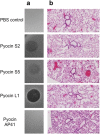Efficacy of species-specific protein antibiotics in a murine model of acute Pseudomonas aeruginosa lung infection
- PMID: 27444885
- PMCID: PMC4957109
- DOI: 10.1038/srep30201
Efficacy of species-specific protein antibiotics in a murine model of acute Pseudomonas aeruginosa lung infection
Abstract
Protein antibiotics, known as bacteriocins, are widely produced by bacteria for intraspecies competition. The potency and targeted action of bacteriocins suggests that they could be developed into clinically useful antibiotics against highly drug resistant Gram-negative pathogens for which there are few therapeutic options. Here we show that Pseudomonas aeruginosa specific bacteriocins, known as pyocins, show strong efficacy in a murine model of P. aeruginosa lung infection, with the concentration of pyocin S5 required to afford protection from a lethal infection at least 100-fold lower than the most commonly used inhaled antibiotic tobramycin. Additionally, pyocins are stable in the lung, poorly immunogenic at high concentrations and efficacy is maintained in the presence of pyocin specific antibodies after repeated pyocin administration. Bacteriocin encoding genes are frequently found in microbial genomes and could therefore offer a ready supply of highly targeted and potent antibiotics active against problematic Gram-negative pathogens.
Conflict of interest statement
The University of Glasgow has filed a patent on the use of pyocins to treat
Figures





Similar articles
-
Discovery, characterization and in vivo activity of pyocin SD2, a protein antibiotic from Pseudomonas aeruginosa.Biochem J. 2016 Aug 1;473(15):2345-58. doi: 10.1042/BCJ20160470. Epub 2016 Jun 1. Biochem J. 2016. PMID: 27252387 Free PMC article.
-
Heterogenous Susceptibility to R-Pyocins in Populations of Pseudomonas aeruginosa Sourced from Cystic Fibrosis Lungs.mBio. 2021 May 4;12(3):e00458-21. doi: 10.1128/mBio.00458-21. mBio. 2021. PMID: 33947755 Free PMC article.
-
F-Type Pyocins Are Diverse Noncontractile Phage Tail-Like Weapons for Killing Pseudomonas aeruginosa.J Bacteriol. 2023 Jun 27;205(6):e0002923. doi: 10.1128/jb.00029-23. Epub 2023 Jun 1. J Bacteriol. 2023. PMID: 37260386 Free PMC article.
-
Pyocins and Beyond: Exploring the World of Bacteriocins in Pseudomonas aeruginosa.Probiotics Antimicrob Proteins. 2025 Feb;17(1):240-252. doi: 10.1007/s12602-024-10322-3. Epub 2024 Jul 18. Probiotics Antimicrob Proteins. 2025. PMID: 39023701 Review.
-
Targeted Killing of Pseudomonas aeruginosa by Pyocin G Occurs via the Hemin Transporter Hur.J Mol Biol. 2020 Jun 12;432(13):3869-3880. doi: 10.1016/j.jmb.2020.04.020. Epub 2020 Apr 25. J Mol Biol. 2020. PMID: 32339530 Free PMC article.
Cited by
-
The Role of Pseudomonas aeruginosa Lipopolysaccharide in Bacterial Pathogenesis and Physiology.Pathogens. 2019 Dec 19;9(1):6. doi: 10.3390/pathogens9010006. Pathogens. 2019. PMID: 31861540 Free PMC article. Review.
-
Variability of murine bacterial pneumonia models used to evaluate antimicrobial agents.Front Microbiol. 2022 Sep 8;13:988728. doi: 10.3389/fmicb.2022.988728. eCollection 2022. Front Microbiol. 2022. PMID: 36160241 Free PMC article. Review.
-
Molecular Structure and Functional Analysis of Pyocin S8 from Pseudomonas aeruginosa Reveals the Essential Requirement of a Glutamate Residue in the H-N-H Motif for DNase Activity.J Bacteriol. 2020 Oct 8;202(21):e00346-20. doi: 10.1128/JB.00346-20. Print 2020 Oct 8. J Bacteriol. 2020. PMID: 32817098 Free PMC article.
-
MvaT negatively regulates pyocin S5 expression in Pseudomonas aeruginosa.Biotechnol Notes. 2022 Dec 9;3:102-107. doi: 10.1016/j.biotno.2022.11.004. eCollection 2022. Biotechnol Notes. 2022. PMID: 39416449 Free PMC article.
-
Mechanisms and Targeted Therapies for Pseudomonas aeruginosa Lung Infection.Am J Respir Crit Care Med. 2018 Mar 15;197(6):708-727. doi: 10.1164/rccm.201705-1043SO. Am J Respir Crit Care Med. 2018. PMID: 29087211 Free PMC article. Review.
References
-
- Souli M., Galani I. & Giamarellou H. Emergence of extensively drug-resistant and pandrug-resistant Gram-negative bacilli in Europe. Eur. Surveil. 13 (2008). - PubMed
-
- Vila J. & Luis Martinez J. Clinical impact of the over-expression of efflux pump in nonfermentative Gram-negative bacilli, development of efflux pump inhibitors. Curr. Drug Targets. 9, 797–807 (2008). - PubMed
-
- Livermore D. M. Multiple mechanisms of antimicrobial resistance in Pseudomonas aeruginosa: our worst nightmare? Clin. Infect. Dis. 34, 634–640 (2002). - PubMed
Publication types
MeSH terms
Substances
Grants and funding
LinkOut - more resources
Full Text Sources
Other Literature Sources
Medical

